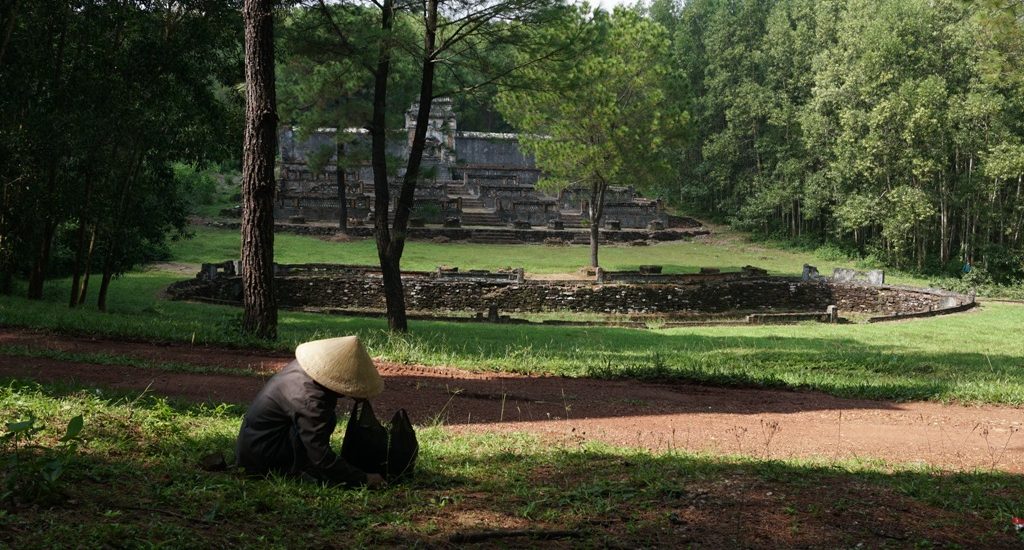I saw a quiet lane running by one side of Xương Lăng – Emperor Thiệu Trị’s tomb so many times when I visited this area but I had never thought that I should take that narrow road until curiosity hit me one afternoon. Not just curiosity but also boredom urged me to discover what lied ahead or by the end of this road. I was surprised to find out that just a few dozens of meters from the beginning of the lane there located someone’s house which faced the west side of Xương Lăng. The uneven road looked like a dried creek carving through the hill and covered with an arched roof made of leaves. Light was scattering it although it was hours before the sun would set and the dark would dominate this place again.
I slowed down when I saw a twin pillars rising high among the pine trees. They hinted me that I should expect an imperial tomb and indeed by the time I got near the first one, through the pine trunks, I saw a massive weather-beaten and crumbling tomb sitting serenely in an open space surrounded by trees. I obviously recognized that it was Xương Thọ Lăng, Empress Mother Từ Dụ’s tomb, as I had read about it before. I parked my Violet Dragon off the lane and gingerly walked toward the sanctuary. I held my breath when I first beheld such a beauty and solemnity. I felt like I was an intruder trespassing a holy land. The two massive pillars marked as its gate but no visible pathway was found to access the staircases to the tomb from where I stood. There were only layers of grass spread out to the ruin and interrupted by a dried-up rock-paved trench which I believe they would poetically call it a half-moon pond.
“So this place is wide open,” I thought to myself.
Bravely, I decided to walk on the high grass and beaten my own path. Climbing the broken stairs to the imperial tomb, my heart sank when my gaze touched the crumbling and at the same time I felt peaceful and familiar. I had never been here before but for some reason it seemed so close to my heart. When I finally reached her grave, I knew why I felt that way. The style of her grave looked a lot like the one at Khiêm Lăng – the eternal home of her son, Emperor Tự Đức. Perhaps when she passed away at the age of 92 in 1902, her descendants decided to build her a tomb modeling her beloved son’s.
When I stepped on the ground, nobody was there but some black birds flying out from the nearby trees, greeting me with their mysterious sound. This repeated every time I visited her tomb later and it reminded me of stories I read about how empress mothers of Nguyễn Dynasty received guests at their resident (Diên Thọ Palace) inside Huế Imperial City. Honored guests would be welcomed by the eunuchs and royal maids before they were escorted to an empress mother to see a glimpse of her from afar before the curtains were drawn and all the guests could acknowledge her presence was the inaudible whispering.
I sat down on a step at her over-a-hundred-year-old tomb watching the light fading away and thought about her, the empress mother I briefly knew between the lines in some books and the lady who earned so much love and respect from her husband and son, the kings of Nguyễn Dynasty. She was also a special history witness of this dynasty who lived through the ruling of its 10 emperors, from Emperor Gia Long (1802-1820) to Emperor Thành Thái (1889-1907).
I learnt that she’s a brilliant as much as warm-hearted person so I hope she will pardon me for intruding her eternal home when I feel troubled inside and need a serene haven to escape to. Next time when I visit her again, I’ll make sure to bring her a happy story.
Below is a footage I shot at her tomb on various occasions.
